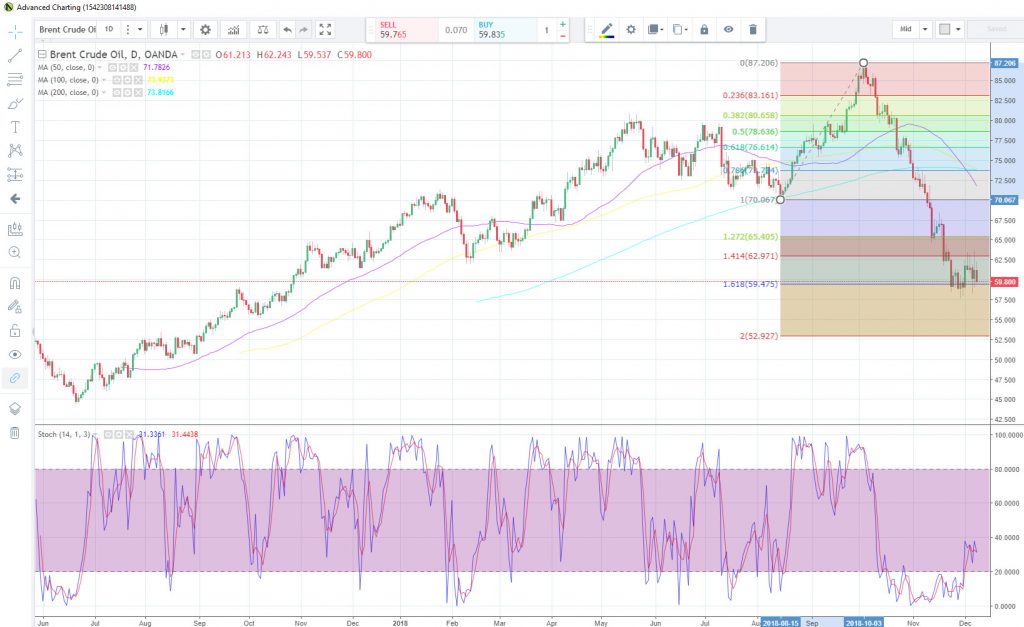West Texas Intermediate crude weakness returned as concerns for slower global growth stemmed from soft Chinese data. Both Brent and WTI have now given up all of their gains that came following last week’s OPEC and allies production cut agreement. The agreement to cut crude supplies by 1.2 million barrels a day, was in the middle of the range of expectations from the beginning of last week.
Over the weekend, trade data showed both imports and exports missed expectations for China, the world’s second largest economy. Softer inflation data suggest that demand remains weak in China. The Chinese trade data also showed weakness with both domestic and international demand.
Oil’s weakness hitting ruble and loonie
Both the Russian ruble and the Canadian dollar declined as oil prices, a key export for both economies, plummeted to start the trading week.
Key stories for Canada
Western Canadian Select’s discount to WTI has improved dramatically over the past couple of weeks and now stands at $12.58. The key turnaround for Canadian prices was the December 2nd announcement that Alberta Canada mandated a 325,000 barrel per day cut in oil output. The province was experiencing a congestion problem and the cut that begins next month should provide an important amount of relief. The Canadian currency fell 0.5% to the greenback and tentatively recaptured the 1.3400 handle. Monetary policy expectations for the Bank of Canada are also starting to come down, just like the Fed. Expectations for a January hike are now called into question and the baseline case for 3 hikes next year could come down.
Key stories for Russia
Russia, the third largest oil producing nation behind the US and Saudi Arabia, however has a higher threshold of pain for low oil prices. Russia can balance its budget with oil in the mid-$50s and most major oil companies can tolerate oil prices closer to $50 a barrel. Russian firms, Lukoil, Gazprom Neft, and Rosneft, have costs that are less than $50 to produce and export one barrel of oil. The one key benefit for the Russian oil firms are that when oil prices are hammered, typically so is the ruble, which means their costs for producing the oil are down. The Russian currency initially traded stronger to start the week, but ended the day down 16.0% to the dollar. Expectations are growing for the Russia Central Bank to raise rates over the next few months.

Analysts dissect OPEC decision
Oil prices remained heavy as analysts begin to outline their outlooks on last week’s decision to cut output. The consensus is that they see Brent roughly higher by $10 next year.
Barclays
Following last week’s production cuts, Barclays analysts see upside for oil prices. Their note said, “changes to supply expectations make a material difference to our balances, taking out 0.5 mb/d of supply and bringing the supply/demand balance to almost zero in 1H18 compared with our early November estimates.”
Goldman Sachs
Highlighted that uncertainty persist after the decision due to the lack of country allocations and exemptions for Iran, Venezuela, and Libya. Sees Brent curve coming back to backwardation and spot prices near $70 a barrel.
Morgan Stanley
Viewed the OPEC + production cuts as sufficient to balance market in H1 and prevent inventories from building. They cut their Q2 forecast for next year from $77.50 a barrel to $67.50.
UBS
Targeted Brent to trade around $70 and $80 barrel next year.
Brent crude daily chart
Brent oil’s daily chart shows that price is tentatively finding support the 161.8% Fibonacci expansion level of the end of summer rally. If the bearish move takes out the $57.50 level, we could see bearish momentum target the $53 level. Major support remains the $50 handle. To the upside $65 remains key resistance.
Content is for general information purposes only. It is not investment advice or a solution to buy or sell securities. Opinions are the authors; not necessarily that of OANDA Business Information & Services, Inc. or any of its affiliates, subsidiaries, officers or directors. If you would like to reproduce or redistribute any of the content found on MarketPulse, an award winning forex, commodities and global indices analysis and news site service produced by OANDA Business Information & Services, Inc., please access the RSS feed or contact us at info@marketpulse.com. Visit https://www.marketpulse.com/ to find out more about the beat of the global markets. © 2023 OANDA Business Information & Services Inc.



